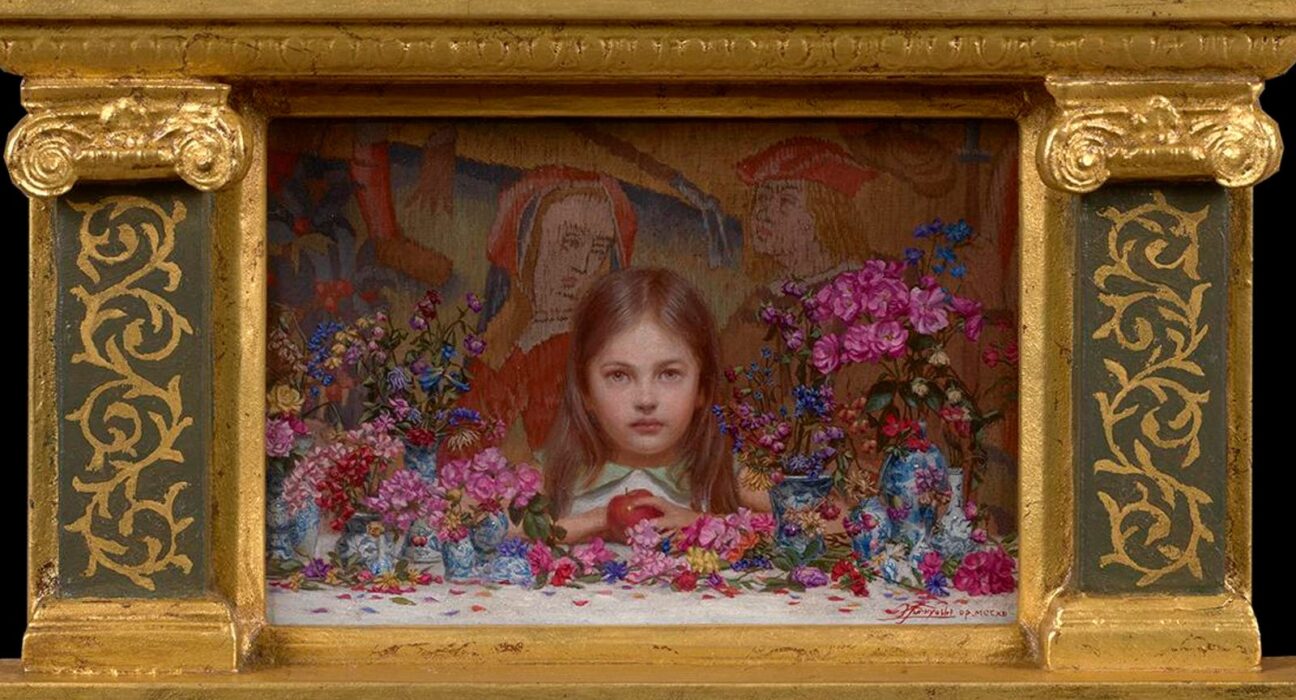The New York Contemporary art auctions are chock-a-block with the works of renowned Japanese superstars. There are Yayoi Kusama pumpkins,
Yayoi Kusama’s “Pumpkin A/ABC”
Christie’s
Yoshitomo Nara angry little girls,
Yoshitomo Nara’s “The Little Ambassador”
Christie’s
and Takashi Murakami over-the-top Japanime sexpots.
Takashi Murakami’s “Hiropon”
Christie’s
These are the types of artists who have already been successfully exported to the West. What, then, of the home-grown painters who sell exclusively in the Japanese auction houses? Are these firms acting as incubators, nurturing the markets for up-and-comers until the day they cross the Pacific?
I was recently introduced to the work of one such painter, who is in the midst of that transition. I was visiting the Rehs Galleries, over on 57th Street here in NYC, and Howard Rehs showed me a small, and I do mean small, painting by the artist Hiroshi Furuyoshi.
There it is, in the above picture, in the middle of the wall, encased in a black frame; the work itself is merely 3.62 x 5.37 inches. It takes the artist 6-8 weeks to paint such a miniature, and he has been known to make his own gilt tabernacle-style frames.
Hiroshi Furuyoshi’s “Amelie”
Rehs Galleries
Certainly, Furuyoshi is mining an entirely different vein than Kusama, et al.. Most obviously, there is the size discrepancy. Kusama gourds can be 5 feet across, Nara’s peeved petites can be 6 feet tall, and poor Amelie would fit in the palm of the 7-foot-tall Hiropon. Perhaps more significant to the art world, though, is Furuyoshi’s chosen inspiration. Not for him the excesses of 20th C. manga. Rather, he channels 19th C. European art. There is a certain irony here, as traditional 19th C. European art is currently languishing in the marketplace. Here, then, is a 21st C. Japanese painter who has chosen to champion that which we Westerners are currently casting aside.
Compare the following two works.
Hiroshi Furuyoshi’s “Julia”
Rehs Galleries
The first piece is a recently executed work by Furuyoshi entitled Julia. The second is Lady Lilith, by the British painter Dante Gabriel Rossetti, which dates from 1867. 150 years separate them, but the parallels are noteworthy; two young, fair-haired, contemplative beauties in white dresses, are shown surrounded by ultra-realistically rendered flowers. Why did Furuyoshi look past Postmodernism, Abstract Expressionism, Modernism, Impressionism etc., and cast his eye back further to 19th C. Pre-Raphaelitism?
It’s all in the family.
Furuyoshi grew up in an antiques store, which his grandfather had founded, surrounded by traditional fine and decorative art. While there, he taught himself art history by reading the art books which his relatives had collected. Then, at the ripe old age of 11, he found himself at a local department store staring at a reproduction of Sir Thomas Lawrence’s 1825 portrait, The Red Boy. Furuyoshi thought to himself, “it would be very cool to be able to paint such a realistic painting”. He eventually was trained how to do just that by the painter Toshiro Aoki. Aoki specialized in painting in the style of the 17th C. Dutch masters and wanted to promote a new Realist movement.
It took a while, but by 1990, Furuyoshi was deemed a professional painter, with several galleries in Tokyo vying to exhibit his works. After building his reputation in the retail market for almost 20 years, his pieces started making their way into the Japanese auction world. This was a very significant step, as private gallery sales are not made public. It is only when pieces trade at auction that everyone can see what the public-at-large is willing to pay for an artist’s works. The Shinwa and Mainichi auction houses started accepting his works for consignment in 2008, and his paintings were seen to fetch prices up to about $10,000 each.
Then, in 2010, he was surprised to see his painting Julien appear in a Christie’s, London ad. What was even more astonishing was how the work ultimately fared. It had been estimated to bring approximately $7,500-10,000, and, when the smoke had cleared, it had fetched almost $59,000. The record for his works now stands at $107,000; oh, and that one also sold in the West.
Now the Rehs Gallery is taking up the challenge of promoting Furuyoshi here in the United States. As the firm had been championing the works of 19th C. European painters for decades, this was a natural fit. Consider the sensibility evident in the following piece from 1895, which they currently have in stock.
George Sheridan Knowles’s “Gladiolas”
Rehs Galleries
Perhaps unsurprisingly, considering Furuyoshi’s affinity for British painters, his works have been selling at English auction houses, not American. Hence, it is not guaranteed that the market here is ready for Furuyoshi. Still, the omens are good. As Lance Rehs, Vice-President of the gallery, wrote me, “all but the one you saw (Amelie) sold within a day of receiving them. In fact, the first one (Ella) sold before we even got it”.
Amelie is priced at $22,000, for those of you who may be interested. By comparison, at a recent auction of fine traditional paintings held here in NY, but one of 138 pieces on offer fetched even that much. It is my hope that the interest in Furuyoshi’s work will rekindle enthusiasm for the 19th C. aesthetic on which it is based. Perhaps it requires someone born a world away to reintroduce us to our own past.

